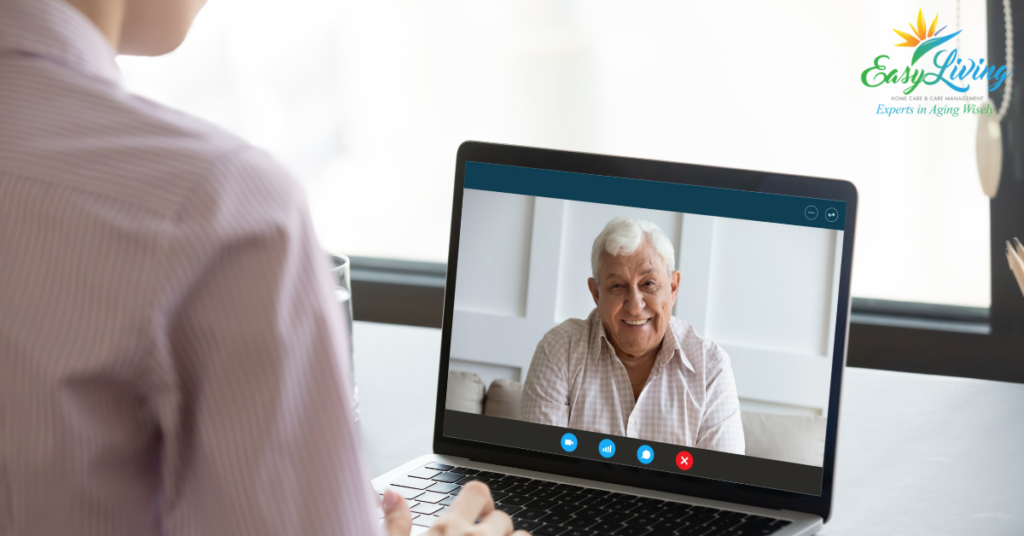The already complex puzzle of caregiving becomes more challenging as a long-distance caregiver. You don’t see the person on a day-to-day basis to spot problems. And, when you’re visiting you’re trying to juggle multiple tasks. You may feel rushed and your love done may therefore feel pressured.
It’s scary for any caregiver when the phone rings in the middle of the night. But, when you’re a remote caregiver it’s even more concerning. Will you need to book an emergency flight? Is your loved one alone in the ER? We’ll tackle how to be a long-distance caregiver and reduce some of the accompanying stress.
How to Be a Remote Caregiver
The first step for any remote caregiver is getting a handle on the level of care your loved one needs right now. The care continuum roughly tends to follow three stages: checking in, full-time monitoring and starting to help with some tasks, and hands-on assistance. Many family members have concerns, but aren’t quite sure exactly how their loved one is doing. This is particularly true for the long-distance caregiver.
You can start by taking a look at our Wellness Checklist, which provides things to look for and key questions to ask:
A professional care management assessment is the key to unlocking the true picture of your loved one’s needs. The assessment identifies potential trouble areas and steps that should be taken in the short-term and for preventing future crises.
Steps for the Long Distance Caregiver
1. Lay the foundation.
Have conversations.
It is essential to open up the lines of communication with your older loved ones. What do they want? What do they have in place? Attempting to jump in during a visit when there’s a crisis can be difficult enough. It can be disastrous if you’re starting with a blank slate.
Imagine if you’ve been reticent to bring things up and your Mom lands in the ER. But, you don’t know anything about where Mom keeps any of her documents. You aren’t even sure what documents she has or know any of her recent medical history. Think of how difficult it will be to make decisions with no idea what she’d want. Just dealing with the practicalities becomes a mess. While your situation may not be so extreme, this example illustrates why this foundation is so vital.
Set up communication. Tap into care technology.
When you can’t be nearby, video calling is a way to not only hear how Mom is doing, but to see her. Smart speakers and smart home systems mean you’re just a voice prompt away. Plus, they have a lot of add-on features that can help with monitoring and safety. Additionally, technology can facilitate how you can help with various tasks from a distance. It is easier than ever to help manage your parents’ finances. And, care technology helps you keep up with their appointments and more. For example, the system we use at EasyLiving provides a shared calendar and secure messaging so the entire care team can work together.
Find out about local resources.
Set up some basic services, such as transportation. This is one of the first areas where an elder may need help. Even if they continue driving, they may not be comfortable (or safe) driving at night or outside of their neighborhood. For example, we have clients who drive to their local stores. However, they would not be comfortable driving over to Tampa or down to St. Petersburg to get to a specialist appointment at a hospital.
Let us help! Contact us at 727-447-5845 or online so we can help you identify and set up care technology and other resources.
2. Address safety issues.
Falls are the #1 threat to an elder’s health and safety when living alone. Making sure the home is “aging in place friendly” minimizes the chances of getting one of those middle of the night calls. We offer a free falls prevention assessment, so be sure to take advantage of this. You can learn more about how it works in the video below.
Get a Free Home Safety Assessment
Another resource for this stage is a monitoring or emergency response system. These range from the simple “I’ve fallen and I can’t get up” buttons to smart pill dispensers and activity monitors that alert you to problems. Some fall systems now come with fall detection and other systems are GPS-enabled. We can recommend the options that will best address your needs and work for your loved one.
3. Set up in-home care.
If your loved one is starting to have trouble with daily activities like dressing or bathing, consider an in-home caregiver. Beyond help with tasks, they also provide socialization which is so important to wellbeing. And, they can keep an eye on things for you and help with household tasks too.
Older adults commonly take multiple medications. Medication errors are common and cause an array of problems, from cognitive difficulties to falls. In-home caregivers can assist with medications to prevent such issues.
Check out what you should know before hiring an in-home caregiver.
Managing Care as a Long Distance Caregiver
Hiring care is just the first step. As a remote caregiver, you’ll want to be kept informed. And, you may have other family members and people helping out with care to keep informed and on the same page. You need to know how things are going and be able to spot changes or concerns. Companies like EasyLiving help you by providing care technology, such as shared family calendars, secure messaging, updates, remote condition monitoring, and assessments to catch key issues.







